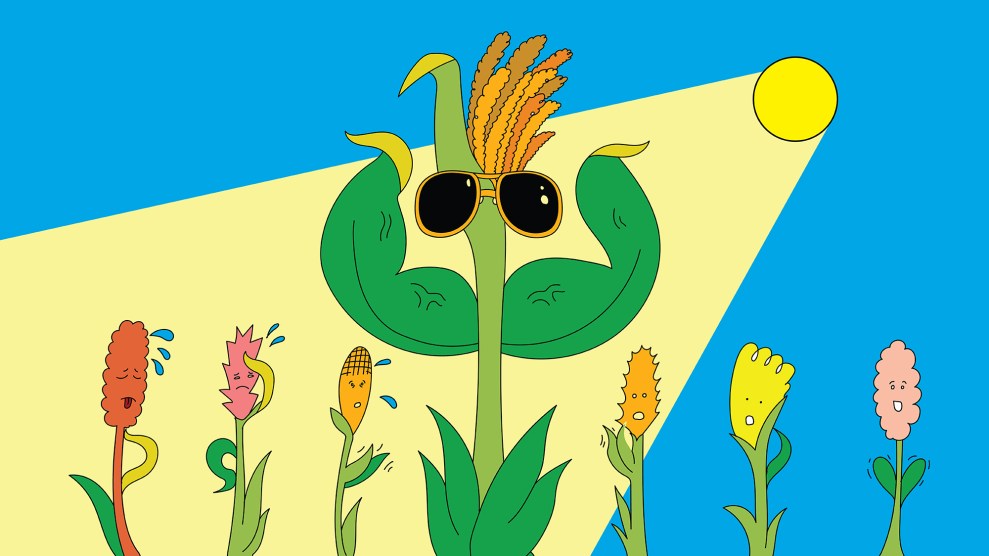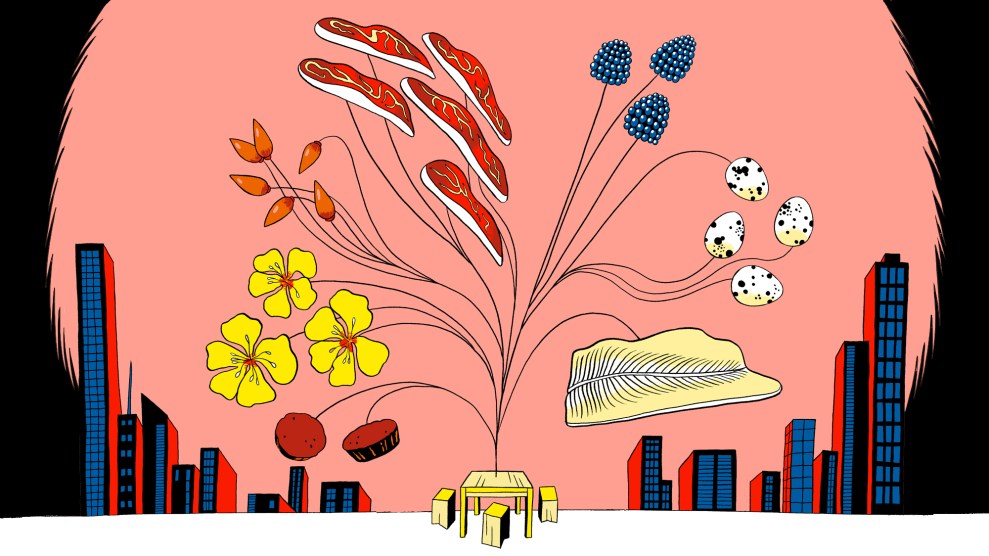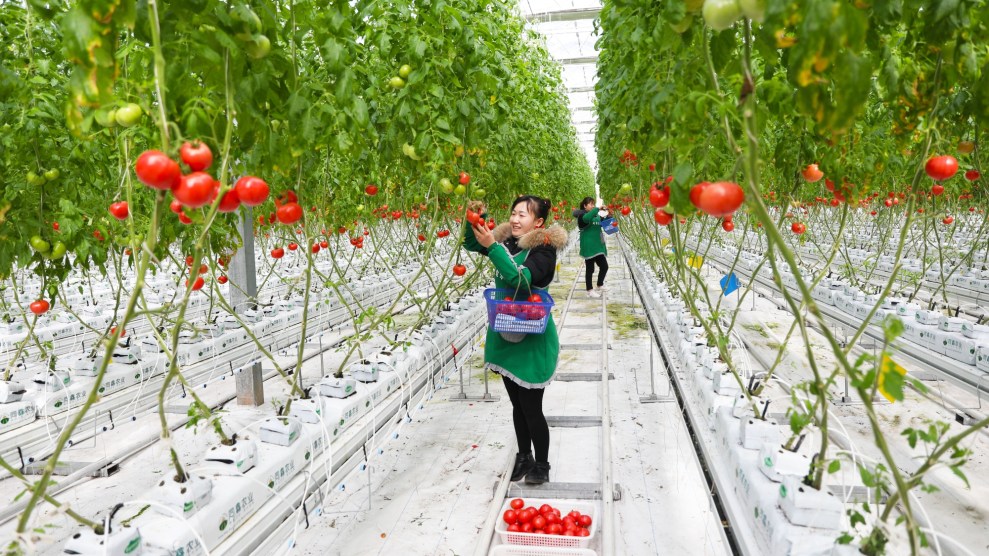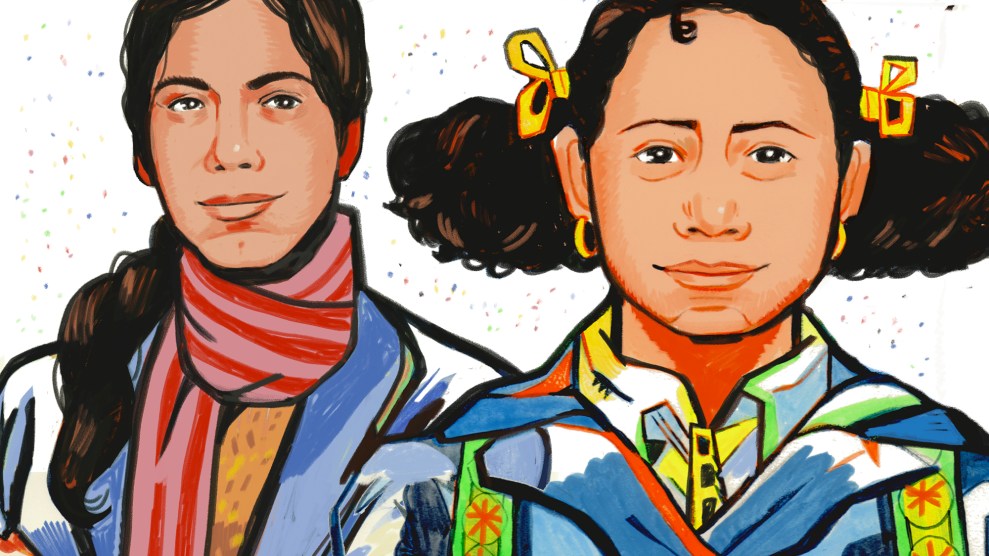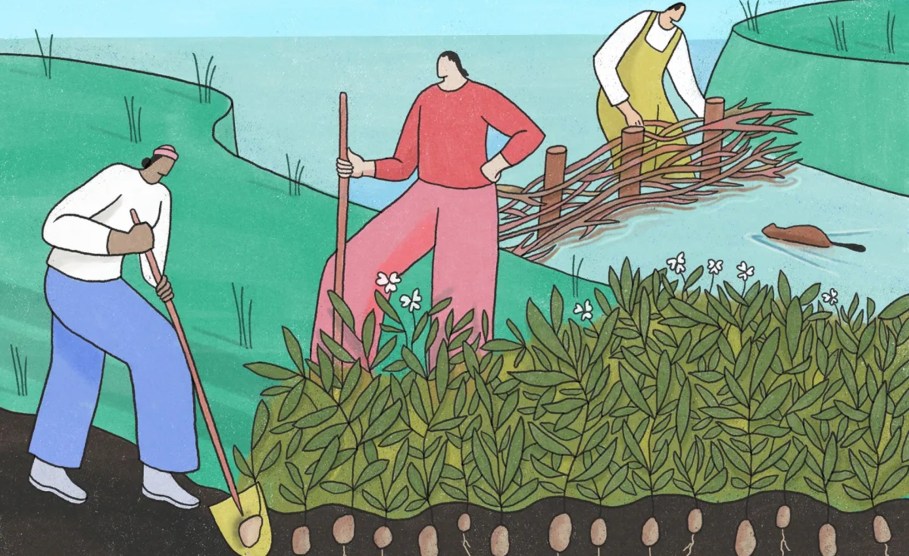
Alexandra Bowman/Vox
This story was originally published by Vox.com and is reproduced here as part of the Climate Desk collaboration.
Last October, Aiyana James attended her first water potato harvest on the reservation of the Coeur d’Alene Tribe in northwestern Idaho. The weather was unusually cold, but she was determined to harvest her first water potatoes, a small wetland tuber that’s one of the tribe’s key traditional foods.
The smell of smoke and drying elk meat filled the air along the shore of Lake Coeur d’Alene, where the tribe set up food booths and educational stations. She waded into the frigid water barefoot to dig for the small tubers, while back on land, tribal members cooked them in a traditional pit bake, where elk, camas (a flowering plant with edible bulbs), and other locally harvested foods are layered.
James, who grew up in Portland, Oregon, and spent summers and school breaks on the reservation, was excited to take part in the harvest for the first time after moving to the reservation after college. But something was wrong: Early-season snow dampened the harvest, and although it was only a light dusting, tribal leaders spoke during the opening prayers about how unusual the conditions were. It had been a dry summer, and the water potato harvest was bad, something that has been happening more and more in recent years.
“I know that this isn’t supposed to be how it is,” James said. “Deep down within me, I’m like, ‘This just doesn’t feel right.’”
“The tribe is able to prioritize things on a far longer time scale than state and federal agencies.”
After their land in northwest Idaho was carved up by 1909 federal allotment policies, Western agriculture, and logging that persists on some level today, the Coeur d’Alene Tribe lost a massive amount of acreage and, with it, their ability to manage the land and maintain balance between environmental protection and economic development. Salmon and trout disappeared from the streams. Fires became more frequent and powerful. Water potatoes and other key plants like camas, once staple foods for tribal members, started to disappear.
Now, extreme drought is making the situation even worse.
All of this is part of a reinforcing cycle of land degradation and climate change that the Coeur d’Alene tribe has been fighting for decades. It’s a fight that James has now joined as one of the tribe’s first climate resilience coordinators.
To protect their land and community, the Coeur d’Alene are in the middle of an ongoing, multidecade effort that relies, in part, on elder knowledge to restore an important wetland.
The tribe is bringing back beavers and salmon, restoring native grasses, and repairing stream channels. Collectively, those efforts are designed to restore balance to the landscape, make it more resilient to future climate change by fostering interconnected ecosystems, and, tribal members hope, one day allow them to rely again on important ancestral foods like the water potato.
“We’ve been living off of the foods that are on our land for thousands upon thousands of years,” James said. “Reconnecting with that food reconnects us with our land.”
Across the country, ecological restoration is increasingly seen as a key part of the fight against climate change, and wetlands provide an especially important service in an era of global warming: They absorb carbon from the atmosphere.
For the Coeur d’Alene tribe, a healthy wetland signifies a way to curb rising temperatures that will provide the basis for the return of a rich food source and a traditional way of life. That a wetland serves as the lynchpin means that the tribe is taking on the restoration of an ecosystem that is especially threatened as the world’s climate trends hotter and more arid. Because wetlands are areas where water is at or near the surface for large parts of the year, severe bouts of drought made more common by climate change threaten their existence.
According to the US Fish and Wildlife Service, more than half of the wetlands in the lower 48 states are gone, and the rate of loss is only accelerating. Between 2009 and 2019, an area of vegetated wetlands in the US the combined size of Rhode Island disappeared.
“You can’t just clear-cut a mountain and say, ‘Oh, now we’ve defeated the fire problem.’ There’s way more to it than that.”
There’s an overarching effort underway to help these imperiled landscapes. The 2022 Infrastructure Investment and Jobs Act included $1.4 billion for ecosystem restoration and resilience, while President Joe Biden also signed an executive order setting a national goal to conserve at least 30 percent of the country’s lands and waters by 2030.
The Coeur d’Alene aren’t alone in their focus on restoration, but they’re especially good at it. And their uniquely patient, humble approach could serve as a model for other communities working to restore the environment and prepare for climate change.
Tribal knowledge and expertise is especially important for restoration because Indigenous people are the ones who know what the land was like before it was degraded and what techniques will help restore it. The thread that ties it all together is traditional food, like the water potato. These cultural foods build connections between people and land and act as an especially tangible measuring stick of the impact that those connections can have on the environment.
James says that camas, for example, grows better when it is regularly harvested. But because so much Coeur d’Alene land is now owned by non-Indigenous people, tribal members often don’t have access to camas fields, and some that have been unattended for years are now suffering.
“We need these foods, but they also need us to flourish and to grow and get better,” she said. “If we do these things right and we focus on restoring our relationship and restoring our connection with our culture, sovereignty, and traditions, then that’s going to have lasting effects.”
On the Coeur d’Alene reservation, soil health and biodiversity have declined, the water temperature is rising, and extreme weather like heat waves and drought are increasingly frequent. But the tribe’s restoration work is beginning to pay off.
In the summer of 2022, an adult salmon swam in Hangman Creek for the first time in around 100 years. Two years after the tribe released juvenile salmon into the creek, and after an arduous journey out to the Pacific Ocean and back, the tribe welcomed salmon back to the creek for the first time in generations.
For Ralph Allan Jr., the tribe’s fish and wildlife program manager, it was the culmination of 20 years of work that began with long days of fieldwork like planting trees. Now, he’s leading the department as it prepares to bring salmon back to the reservation.
Allan is also working to plant the seeds for a new generation of restoration advocates. He has led an internship program to get college students out in the field and three tribal members are currently enrolled in fish and wildlife degree programs. At the water potato harvest, Allan makes sure that department staff are working with the youth, showing them how to harvest the potatoes and pulling the kids out of the mud when they get stuck.
This cultural and community work is part of the tribe’s restoration effort. Allan worries that the tribe’s younger generation is not as connected to the land as he was growing up. “We’re not just reintroducing the species of salmon back to our people,” he said. “We’ve lost that cultural connection to the salmon as well, so we’re reintroducing a whole culture of salmon.”
While salmon are a priority, they are just one piece of a complicated, interconnected ecosystem the tribe is working to restore. Take beaver dams. Dams raise the water table, extend the area along the banks of a river or lake that more animals and plants can inhabit, and keep more water on the landscape. All of this makes the area more welcoming to salmon and other wildlife, but also makes the landscape more resilient to drought and extreme heat because wetlands absorb and retain water that is released during drier periods, explains Tyler Opp, the tribe’s wetlands coordinator.
“The tribe is able to prioritize things on a far longer time scale than state and federal agencies.”
The beaver dams also support clean, cold-water habitats for salmon, but to do that, they need trees. Since 2019, the tribe’s environmental programs department has planted over 18,000 trees from about a dozen different species, and plans to plant another 4,000 by 2025.
The tribe has used beaver dam analogs—man-made approximations—to encourage beavers to return and posts to reinforce existing beaver dams. Gerald Green, a wildlife biologist for the tribe, says they are currently supporting about seven beaver dams in the creek.
Trees, beavers, salmon, water—they’re all part of a cyclical, interdependent system the tribe is trying to restore and support. Cajetan Matheson, natural resource director and a tribal council member, says that addressing climate impacts or restoration goals one by one will not work. “Everything is really related to each other,” Matheson said. “You can’t just clear-cut a mountain and say, ‘Oh, now we’ve defeated the fire problem.’ There’s way more to it than that.”
These projects take time. Tyler Opp says that even though the scale of the work that needs to be done can be overwhelming, the tribe’s approach helps keep things in perspective.
By keeping longer-term goals in mind, like bringing salmon back, which could take decades, the tribe avoids Band-Aid solutions. The whole tribal government buys into this approach, year after year and generation to generation, and although the tribe is limited by funding and capacity, like many public agencies, this commitment allows them to focus on projects that will contribute to achieving that long-term vision. Despite the constraints, the tribe can unify behind a shared vision of the future, based on their collective history, knowledge, and appreciation for the land.
“The tribe is able to prioritize things on a far longer time scale than state and federal agencies,” he said. “The tribe doesn’t have to think in terms of the next budget cycle for getting work done. All of [the things we are doing] are done for future generations.”
Almost everyone I talked to in the Natural Resources Department credits that perspective to Felix Aripa, a tribal elder who died in 2016. He is seen as instrumental in setting the tone for the tribe’s restoration work.
Even Aiyana James, who never had the chance to meet him, says she’s listened to old tapes of Aripa. He was an early proponent of using beavers as a restoration partner and helped with things as straightforward as pointing out where a stream used to flow so that the technicians could use that as a guideline to restore the course rather than starting from scratch or guesswork. “The ultimate goal for anybody that works here in the Fish and Wildlife Program is to leave a legacy the way that Felix Aripa left his legacy and his mark on the program,” Allan said.
Before he passed away, Aripa helped Matheson and others put the tribe’s traditional seasonal calendar on paper. The calendar, which is based on seasonal indicators like tree sap rather than months and days, includes detailed information about foods, ecosystems, plants, animals, and human activities. “As we’re thinking broadly about how we approach restoration, it’s the framework that we can use,” Laura Laumatia, the tribe’s environmental programs manager, said. “It represents millennia of knowledge.”
So while the tribe is proud of their progress, they are still working for the future. “I think it’s nice to work for 20 years in the same place because you do see some changes happening,” Laumatia said. “But we know that the fruits of our labor are really going to be 70 years from now.”
